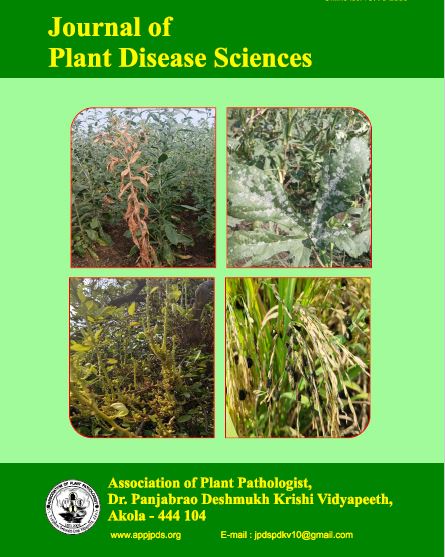EFFICACY OF FUNGICIDE MOLECULES AND BIOAGENTS AGAINST CHARCOAL ROT OF SOYBEAN
DOI:
https://doi.org/10.48165/jpds.2025.20.01.05Keywords:
Bio-agents, Charcoal rot, Fungicides, Soybean, Macrophomina phaseolinaAbstract
Soybean is one of the most economically important legumes worldwide. However, diseases serve as significant biotic constraints in soybean production. Among them, charcoal rot caused by Macrophomina phaseolina is a major disease responsible for substantial yield losses. In the present investigation, five fungicides and three bio-agents were evaluated for their efficacy against M. phaseolina. In in vitro conditions, Carboxin 37.5% + Thiram 37.5% DS and Carbendazim 12% + Mancozeb 63% WP exhibited 100% inhibition of the mycelial growth of the pathogen. Among the bio-agents tested, Trichoderma viride showed the highest mycelial growth inhibition (58.33%), followed by Pseudomonas fluorescens (38.88%). Under greenhouse conditions, Carboxin 37.5% + Thiram 37.5% DS and Carbendazim 12% + Mancozeb 63% WP were found to be the most effective, achieving 77.78% disease control of charcoal rot. This was followed by Thiophanate methyl 45% + Pyraclostrobin 5% FS (55.56%), Trichoderma viride (33.33%), and Pseudomonas fluorescens (22.22%).
References
Das, I. K., Rao, P. S. V., & Reddy, S. V. (2007). Screening technique for sorghum disease. International Journal of Research in Biosciences and Agricultural Technology, 4(1), 176–178.
International Crops Research Institute for the Semi-Arid Tropics (ICRISAT). (n.d.). Screening technique for sorghum disease. Information Bulletin No. 76, pp. 40–46.
Dennis, C., & Webster, J. (1971). Antagonistic properties and species groups of Trichoderma II. Production of volatile antibiotics. Transactions of the British Mycological Society, 57, 363–369.
Umer Iqbal, & Tariq Mukhtar. (2013). Morphological and pathogenic variability among isolates of Macrophomina phaseolina associated with mungbean (Vigna radiata L. Wilczek) from Pakistan. Scientific World Journal, 15, Article ID 950175.
Varma, R. K., & Pathe, A. (2013). Morphological and cultural variability of Rhizoctonia bataticola responsible for charcoal rot of soybean. JNKVV Research Journal, 47(1), 88–94.
Vincent, J. M. (1947). Distortion of fungal hyphae in the presence of certain inhibitors. Nature, 159, 850.

